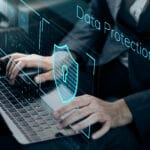Cybercriminals constantly seek to exploit stolen data for nefarious purposes. Understanding how they benefit from this data is essential for recognizing the risks and reinforcing security measures. According to the Identity Theft Resource Center’s (ITRC) 2023 Data Breach Report, the past year brought about a somber realization that cybercriminals have grown more relentless than ever. In the first quarter of 2024, ITRC recorded 841 publicly reported data compromises — up 90% over Q1 2023 — with no signs of slowing down. Here are eight reasons why bad actors are always hungry for fresh data.
Stolen data has a myriad of profitable uses for bad actors. Here are some ways cybercriminals exploit stolen data:
FINANCIAL GAIN
Of course, money is almost always the biggest motivator for cybercrime. Cybercriminals use stolen data to make money through:
Direct financial fraud
- Credit card fraud: Stolen credit card information can be used to make unauthorized purchases or create fake credit cards.
- Bank fraud: Cybercriminals can use stolen banking information to withdraw money, transfer funds or create fake accounts.
Sale on the dark web
- Personal information: Personal details such as names, addresses, social security numbers and dates of birth are sold to other criminals for identity theft.
- Credentials: Login credentials for various online services, including email, social media and financial accounts, are valuable commodities on the dark web.
IDENTITY THEFT
Personal data can easily be turned for a profit as it can be used to facilitate activities like:
Creating fake identities
- New account fraud: Using stolen personal information, criminals can open new accounts in victims’ names, including bank accounts, credit lines and utility services.
- Tax fraud: Fraudulent tax returns can be filed using stolen personal information to claim tax refunds.
Medical identity theft
- Healthcare fraud: Cybercriminals can use stolen health insurance information to receive medical care, purchase prescription drugs or file fraudulent insurance claims.
CORPORATE ESPIONAGE
Every business wants to keep an eye on its competitors. Here’s how bad actors profit from proprietary or corporate data:
Competitive advantage
- Trade secrets: Stolen intellectual property, such as product designs, proprietary algorithms and business plans, can be sold to competitors or used to gain a competitive edge.
- Market manipulation: Confidential information about a company’s financials or upcoming mergers can be used for insider trading or to manipulate stock prices.
EXTORTION AND RANSOM
Bad actors will stoop to using almost any tactics to make a profit, including snatching data and holding it hostage by carrying out cyberattacks like:
Ransomware attacks
- Data encryption: Cybercriminals encrypt a victim’s data and demand a ransom to provide the decryption key. This can cripple businesses, forcing them to pay to regain access to their own data.
- Data exposure: Threatening to release stolen sensitive information unless a ransom is paid, causing reputational damage or legal consequences for the victim.
EXPLOITING CREDENTIALS
Credentials are incredibly valuable. They’re the proverbial keys to a company’s kingdom, and cybercriminals won’t hesitate to use them for:
Account takeover
- Service access: Stolen login credentials allow criminals to access various online services, from email accounts to cloud storage, leading to further data theft or fraudulent activities.
- Credential stuffing: Using stolen credentials on multiple websites, exploiting the fact that many people reuse passwords across different services.
SOCIAL ENGINEERING AND PHISHING
Phishing is a low-overhead operation that can be the opening gambit to many more serious cyberattacks. Stolen data can be utilized for phishing in the form of:
Targeted attacks
- Spear phishing: Detailed personal information allows cybercriminals to craft highly convincing phishing emails targeted at specific individuals or organizations.
- Social engineering: Using personal details to manipulate individuals into divulging further sensitive information or performing actions that compromise security.
SPREADING MALWARE
Malware, including ransomware, is the scourge of cybersecurity. Data theft is also a path toward malware attacks through:
Malicious campaigns
- Email compromise: Compromised email accounts can be used to send malware-laden emails to contacts, spreading infections and gaining further access to networks.
- Botnets: Stolen data can facilitate the creation of botnets, networks of infected devices used to conduct large-scale cyberattacks, such as distributed denial-of-service (DDoS) attacks.
POLITICAL AND SOCIAL MANIPULATION
The shadowy world of international intrigue is fueled by information. Stolen data can be used in political actions like:
Disinformation campaigns
- Influence operations: Personal data can be used to tailor disinformation campaigns, targeting individuals with specific political ads or misleading information to influence public opinion.
- Election interference: Compromised information can be used to disrupt or influence the outcome of elections, creating instability and undermining democratic processes.
Do you have questions about your cybersecurity or educating your staff about the risks of clicking on the wrong link? Reach out to I.T. Solutions of South Florida; we are here to help!
Article courtesy Kaseya





